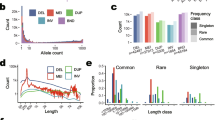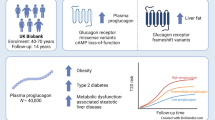Abstract
Insulin resistance, which is pathogenic for type 2 diabetes (T2D), is under the control of largely unknown genetic determinants. LAR, a protein-tyrosine phosphatase which inhibits insulin signalling, is overexpressed in animal and human models of insulin resistance. We studied the entire sequence of the LAR gene by SSCP analysis and automatic DNA sequencing, with the aim of verifying whether its sequence variants might be associated with insulin resistance. In the 276 bp sequence upstream of the transcriptional start site (i.e. a region we have identified as having basal promoter activity) a –127 bp T→A SNP (5% frequency) was associated with lower body mass index (BMI) (P=0.03), waist circumference (P=0.01), blood pressure (P=0.01) and urinary albumin/creatinine ratio (P=0.04) in 589 non-diabetic unrelated individuals from the Gargano region (central east coast of Italy). To quantify the risk for a high body weight conferred by the –127 T→A SNP, the whole cohort was divided into tertiles according to the individual BMI. The risk of belonging to the heavier tertile, as compared to the leaner one, was reduced by approximately 60%. In a population from East Sicily (n =307), T/A genotype carriers (n =13) showed lower triglyceride levels (P=0.04) and higher insulin sensitivity as indicated by lower plasma glucose (P=0.03) and serum insulin (P=0.006) during oral glucose tolerance testing (OGTT). Promoter activity, studied by cDNA transfection experiments, was similar for the A and T alleles. In conclusion, a genetic variant of the LAR gene promoter is consistently associated with features of insulin resistance in two different Caucasian populations. Although the biological relevance of this variant has yet to be determined, this finding underlines the potential importance of the LAR gene in dysregulation of insulin sensitivity and related disorders.

Similar content being viewed by others
References
Reaven GM (1988) Role of insulin resistance in human disease. Diabetes 37:1595–1607
Kahn BB, Flier J (2000) Obesity and insulin resistance. J Clin Invest 106:473–481
Stern MP (2000) Strategies and prospects for finding insulin resistance genes. J Clin Invest 106:323–327
Almind K, Doria A, Kahn CR (2001) Putting the genes for type 2 diabetes on the map. Nat Med 7:277–279
Virkamaki A, Ueki K, Kahn CR (1999) Protein-protein interaction in insulin signaling and the molecular mechanisms of insulin resistance. J Clin Invest 103:931–943
Goldstein BJ, Ahmad F, Ding W, Li P, Zhang W (1998) Regulation of the insulin signaling pathway by cellular protein-tyrosine phosphatases. Mol Cell Biochem 182:91–99
Elchebly M, Payette P, Michaliszyn E, Cromlish W, Collins S, Loy AL, Normandin D, Cheng A, Himms-Hagen J, Chang CC, Ramachandran C, Gresser MJ, Tremblay ML, Kennedy BP (1999) Increased insulin sensitivity and obesity resistance in mice lacking the protein tyrosine phosphatase-1B gene. Science 283:1544–1548
Klaman LD, Boss O, Peroni OD, Kim JK, Martino JL, Zabolotny JM, Moghal N, Lubkin M, Kim YB, Sharpe AH, Stricker-Krongrad A, Shulman GI, Neel BG, Kahn BB (2000) Increased energy expenditure decreased adiposity and tissue-specific insulin sensitivity in protein tyrosine phosphatase 1B-deficient mice. Mol Cell Biol 20:5479–5489
Tsujikawa K, Kawakami N, Uchino Y, Ichijo T, Furukawa T, Saito H, Yamamoto H (2001) Distint functions of the two protein tyrosine phosphatase domains of LAR (leucocyte common antigen-related) on tyrosine dephosphorylation of the insulin receptor. Mol Endocrinol 15:271–280
Ahmad F, Goldstein BJ (1997) Functional association between the insulin receptor and the transmembrane protein-tyrosine phosphatase LAR in intact cells. J Biol Chem 272:448–457
Zabolotny JM, Kim Y, Peroni OD, Kim JK, Pani MA, Boss O, Klaman LD, Kamatkar S, Shulman GI, Kahn BB, Neel BG (2001) Overexpression of the LAR (leucocyte antigen-related) protein-tyrosine phosphatase in muscle cause insulin resistance. Proc Natl Acad Sci USA 98:5187–5192
Ren J, Li P, Zhang W, Sweet LJ, Cline G, Shulman GI, Livingston JN, Goldstein BJ (1998) Transgenic mice deficient in the LAR protein-tyrosine phosphatase exhibit profound defects in glucose homeostasis. Diabetes 47:493–497
Ahmad F, Considine RV, Goldstein BJ (1995) Increased abundance of the receptor-type protein-tyrosine phosphatase LAR accounts for the elevated insulin receptor dephosphorylating activity in adipose tissue of obese human subjects. J Clin Invest 95:2806–2812
Ahmad F, Azevedo JL, Cortright R, Dohm GL, Goldstein BJ (1997) Alterations in skeletal muscle protein-tyrosine phosphatase activity and expression in insulin-resistant human obesity and diabetes. J Clin Invest 100:449–458
Di Paola R, Frittitta L, Miscio G, Bozzali M, Baratta, Centra M, Spampinato D, Santagati MG, Ercolino T, Cisternino C, Soccio T, Mastroianno S, Tassi V, Almgren P, Pizzuti A, Vigneri R, Trischitta V (2002) A variation in the 3′ UTR of hPTP1B increases specific gene expression and associates with insulin resistance. Am J Hum Genet 70:806–812
Frittitta L, Ercolino T, Bozzali M, Argiolas A, Graci S, Santagati MG, Spampinato D, Di Paola R, Cisternino C, Tassi V, Vigneri R, Pizzuti A, Trischitta V (2001) A cluster of three single nucleotide polymorphism in the 3′-untraslated region of human glycoprotein PC-1 gene stabilises PC-1 protein content and insulin resistance-related abnormalities. Diabetes 50:1952–1955
Chen C, Okayama H (1987) High-efficiency transformation of mammalian cells by plasmid DNA. Mol Cell Biol 7:2745–2752
Schneider S, Roessli D, Excoffier L (2000) Arlequin v 2.000: A software for population genetics data analysis. Genetics and Biometry Laboratory, University of Geneva, Switzerland
Echwald SM, Bach H, Vestergaard H, Richelsen B, Kristensen K, Drivsholm T, Borch-Johnsen K, Hansen T, Pedersen O (2002) A P387L variant in protein tyrosine phosphatase-1B (PTP-1B) is associated with type 2 diabetes and impaired serine phosphorylation of PTP-1B in vitro. Diabetes 51:1–6
Mok A, Cao H, Zinman B, Hanley AJG, Harris BS, Kennedy BP, Hegele R (2002) A single nucleotide polymorphism in protein tyrosine phosphatase PTP-1B is associated with protection from diabetes or impaired glucose tolerance in Oji-Cree. J Clin Endocrinol Metab 87:724–727
Mattock MB, Morrish NJ, Viberti G, Keen H, Fitzgerald AP, Jackson G (1992) Prospective study of microalbuminuria as predictor of mortality in NIDDM. Diabetes 41:736–741
Wu X, Hoffstedt J, Deeb W, Singh R, Sedkova N, Zilbering A, Zhu L, Park PK, Arner P, Goldstein BJ (2001) Depot-specific variation in protein-tyrosine phosphatase activities in human omental and subcutaneous adipose tissue: a potential contribution to differential insulin sensitivity. J Clin Endocrinol Metab 86:5973–5980
Kennedy BP, Ramachandran C (2000) Protein tyrosine phosphatase-1B in diabetes. Biochem Pharmacol 60:877–833
Zinker BA, Rondinone CM, Trevillyan JM, Gum RJ, Clampit JE, Waring JF, Xie N, Wilcox D, Jacobson P, Frost L, Kroeger PE, Reilly RM, Koterski S, Opgenorth TJ, Ulrich RG, Crosby S, Butler M, Murray SF, McKay RA, Bhanot S, Monia BP, Jirousek MR (2002) PTP1B antisense oligonucleotide lowers PTP1B protein, normalises blood glucose, and improves insulin sensitivity in diabetic mice. Proc Natl Acad Sci USA 99:11357–11362
Acknowledgements
This research was supported by Telethon Italia grant E1239 and by the Italian Ministry of Health (Ricerca Finalizzata 1999 and Ricerca Corrente 2000).
Author information
Authors and Affiliations
Corresponding author
Additional information
Giuseppe Miscio and Vittorio Tassi contributed equally to the work
Appendix
Appendix
Table 4 gives a list of the primers and PCR conditions for the detection of LAR polymorphisms
Rights and permissions
About this article
Cite this article
Miscio, G., Tassi, V., Coco, A. et al. The allelic variant of LAR gene promoter –127 bp T→A is associated with reduced risk of obesity and other features related to insulin resistance. J Mol Med 82, 459–466 (2004). https://doi.org/10.1007/s00109-004-0544-1
Received:
Accepted:
Published:
Issue Date:
DOI: https://doi.org/10.1007/s00109-004-0544-1




